Annie's Dig Diary June 21-28
 Our excavations have targeted particular areas of the Priory based off the geophysical results:
Our excavations have targeted particular areas of the Priory based off the geophysical results:
Trench 1 is over the corner of the refectory building (the strongest signal on the geophysical survey).
Trench 2 goes from the cloister to the outside of the external wall of what we believe to be the dormitory.
Trench 3 targets the corner of a yet undetermined building, possibly part of the service range or related to the church.
Trench 4 was to investigate the strong signal coming from this area and to establish what sort of feature it might be.
Day One – Monday 21
Despite the absolutely appalling weather we forged ahead with the opening of Trenches 1, 2 & 3. The plough soil is not as deep as we thought and comes directly onto a orange layer, possibly the natural Wealden clay. We weren't able to continue past lunchtime due to the site being too wet to work. Our volunteers cheerfully braved the morning in the wind and rain, so much for the great British summer!
T1 - was placed on top of the refectory in order to pick up the buttress walls. Machining took most of the plough soil off but a thin layer was left to be hand trowelled.
Unfortunately the conditions were too wet to do that today so we focussed on straightening up the sides of the trenches.
T2 - was stripped and some features were appearing, possibly robber trenches associated with the walls of the cloister and dormitory.
T3 - was opened after lunch and produced a rubble chalk wall in a cut feature. We beat a hasty retreat to the tool shed to ride out the worst of the rain so will investigate this further tomorrow.
T4 - Not opened yet

Day Two – Tuesday 22
The day started off wet and we noticed from the farmhouse that the trenches had started flooding overnight. After a quick squelchy walk to analyse the field we decided it was too wet underfoot to continue the excavation today.
The high amount of clay in the soil would have resulted in us churning the ground up with our feet – not good for those shallow archaeological features! It has allowed us to catch up with the all important paperwork, sort our finds out, and even walk down to the pillbox located on the levels to the south of the site (more on that another day!).
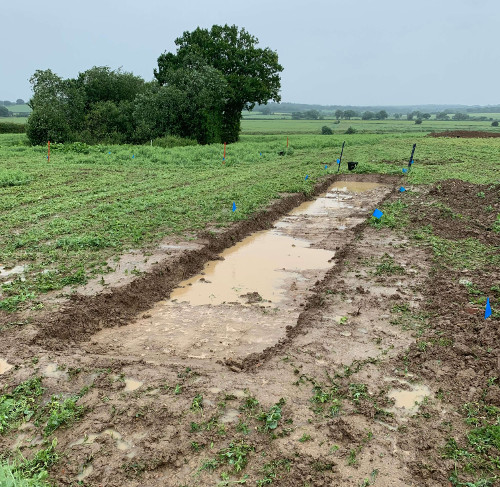
T1 – too wet to work
T2 – flooded!
T3 – flooded!
T4 – opened
Day Three – Wednesday 23
The day was glorious, despite Trenches 2 & 3 remaining flooded. It was our busiest day yet with volunteers and visitors (including those of a four-legged variety!). Progress was good but we encountered our next worst nightmare after flooding – baked soil! Interspersed with copious amounts of tea breaks we were able to start on the excavation proper.
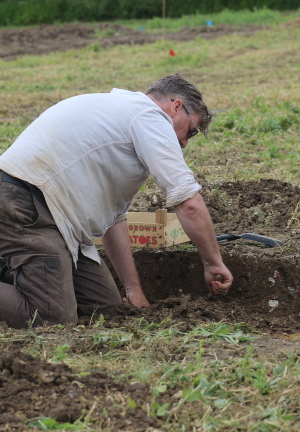
T1 – suffering from being too wet and baked at the same time we started trowelling off the remnants of the plough soil in the areas we wouldn't be making a puddle in. Something
resembling a feature full of stone has appeared but the ether it is a robbed-out trench or the foundations is yet to be seen.
T2 – still flooded so left to drain
T3 – still flooded so left to drain
T4 – the remnants of the plough soil was removed and a large linear feature was discovered. Excavation of this feature was begun and established its width, but not the depth so far.
It is quite a size! Further investigation will tell us whether this is a robbed-out wall or a boundary ditch in due course.
Day Four – Friday 25
Rain again, but only a little. Enough to get us damp but not enough to halt the excavation. Progress was good in all trenches and we are beginning to form a picture of the archaeology preserved under the plough soil.
T1 – we're still taking the plough soil off the top of the trench. Around half of the trench is now uncovered and we have a feature full of rubble, likely to be the robber trench
relating to the refectory. Outside of this appears to be a layer of mixed mortar, plaster, broken stone, and tile probably representing a levelling off of the material once the wall was removed.
T2 – was left to dry out for another day
T3 – trowelling the surface revealed the chalk foundations of a wall return and other pits and ditches.
T4 – there is a large ditch feature around 2m wide and over 1m deep which appears to terminate in the middle of the trench. Finds coming out of this are medieval and early
post-medieval, implying that it is connected to the priory in some way but as yet we are not sure what it is! Theories include a boundary ditch with causeway entrance, a robber trench
(but it is quite large), or something else entirely. The star find today was two complete glazed tiles.
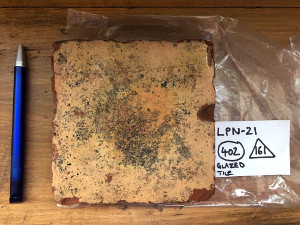
Day Five – Saturday 26
The day started off misty but it soon cleared away. The promised overnight rain didn't materialise so the soil in the trenches is even harder and drier than yesterday. Progress was slow due to the ground being extremely hard, but everyone did very well toiling in the humidity and heat. We managed to find time to treat ourselves to ice cream and a trip to Lossenham Manor open day too. We had the busiest day for visitors too with around 20 people coming to visit the site throughout the day.


T1 – removal of the plough soil continues and it is revealing the robber trench underneath. A small glass object was found, possibly a bead or ornamentation off a vessel, and we had
our first glazed tile (the same style as the ones from T4 yesterday)
T2 – work started in this trench on cleaning up the surfaces after the flooding on Tuesday. The ground is incredibly difficult to work in here but we are making some small progress.
One of the wall trenches produced lead window cane and some medieval window glass.
T3 – some more work continued on the chalk wall to define the edges of the feature
T4 – we left this trench today to focus our efforts on getting Trenches 1 & 2 into shape.
Day Six – Sunday 27
Today was our last day on site until July 19. Our objectives were to get the trenches cleaned up and photographed before covering them over with tarpaulin. Andrew took a group of people on the repeat of the May 27 walk in the morning leaving the rest of us to continue with the cleaning up. The rain (mostly) held off until the last moments of the day so we were successful in putting the trenches to bed until July.
T1 – the robber trench for the refectory building is looking much clearer now the remaining plough soil has been removed. There are a couple of other features popping up in
this trench too.
T2 – this trench flooded then dried out to concrete making it almost impossible to clean up. In the last moments of the day the rain started to show up potential grave cuts
in the cloister courtyard. We were expecting this so it wasn't a surprise!
T3 – the chalk foundation was cleaned up nicely and photographed ready for further investigation. It is much wider than initially thought and we look forward to finding out
which building this belongs to in due course.
T4 – the function of the large feature still eludes us but some progress was made in finding the bottom of it.

Annie's Dig Diary July 19-23
Day Seven – Monday 19
Today we checked the trenches after leaving them exposed to the elements for nearly three weeks. We had covered the important sections with tarpaulin to protect the archaeology from the worst of the weather - which had been decidedly mixed since we were last here with torrential rain and then brilliant sunshine - so we had a lot to get on with!
We have decided to focus on Trenches 1 & 2 this week to establish the extent of the wall trenches. Unfortunately, we were forced to call off early due to a sudden thunderstorm.

T1 – this trench was very dry and compact, but the team managed to make good progress on cleaning up the remains of the refectory wall.
T2 – a slot was started on the outer dormitory wall with more trowelling in the rest of the trench. This trench suffered the most from flooding in June so there was a bit of silty
wash to take off the top (which had unfortunately baked solid in the subsequent sunshine).
Day Eight – Tuesday 20
This morning started with a disappointing trip to the trenches to discover the torrential thunderstorms of the previous day had flooded the hard work we had achieved yesterday. Conditions were so bad underfoot we made the decision to cancel the majority of the volunteers for the day so a small team began the job of cleaning up the mess. By the afternoon we had the unenviable situation of a site that was both flooded and baked solid!
Today started the monumental task of finds processing all the material we have been digging up, a pile which only gets bigger every day we excavate. The farm has lent us a large tent for us to shelter beneath and we have turned this into our finds processing place.
We were also able to do two tours in the afternoon so in the end quite a busy day!
T1 – we were only able to get into this trench after lunch but some small progress was made on cleaning the refectory wall up.
T2 – this trench was the most flooded so after bailing the water out we took the decision to extend it by 2m to the north. This was to try and confirm the presence of graves in the
cloister passage but instead we found a convincing wall trench (the wall between the cloister and the dormitory). Whether there are graves or not is still tbc!
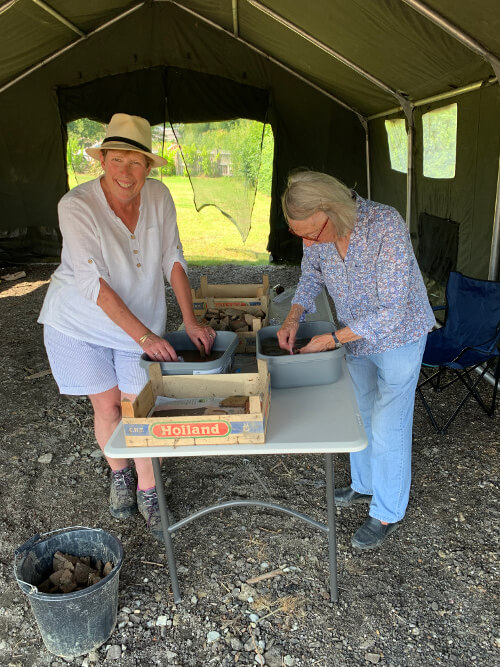
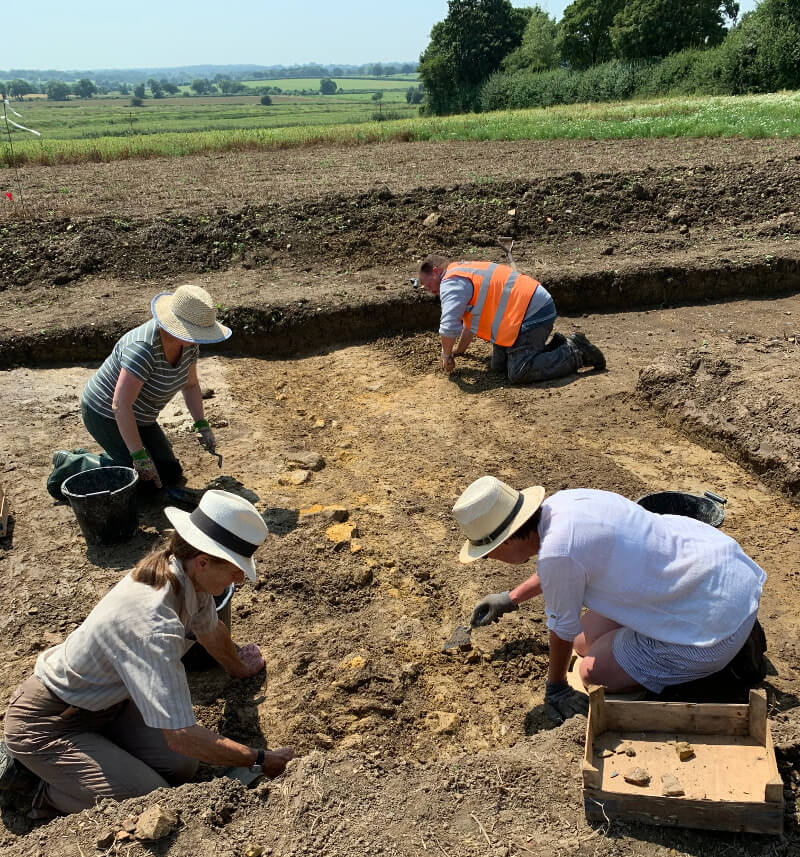
Day Nine – Wednesday 21
Today was an absolute roaster of a day. Thankfully a light breeze came in around lunchtime but even that didn't do much to alleviate the heat. Progress was made, however, despite the oppressive conditions and we had lots of refreshing breaks in the shade.
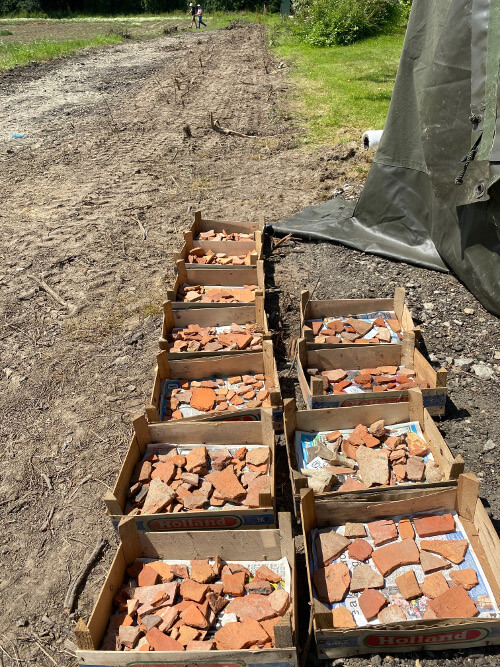
T1 – more of the refectory wall has been defined and is now looking like we have the corner seen in the geophysical results.
T2 – trowelling continues despite the solid nature of the soil. We are attempting the find the other features picked up by the geophysical survey especially the wall between
the cloister and the dormitory. The outer dormitory wall is producing a large amount of roof tile, floor tile, slate, and broken stone, all remnants of the demolition and subsequent
levelling of the priory.
Day Ten – Thursday 22
Excellent progress has been made on both trenches today. The hot weather continues and our volunteers are doing a grand job of balancing the heat with working in exposed conditions.
Our finds processing volunteers continue to do a great job of washing the finds from the excavation. For the most part it's all material from the one context, the wall trench at the back of the dormitory, and if that continues across the site we won't be short of material to wash!
T1 – we have finally finished cleaning this trench and have exposed the wall trenches of the corner of the refectory nicely. There are two buttresses present indicating this building was
quite substantial.
T2 – the external dormitory wall is looking promising with a clear fill and possible drip gully. The rest of the trench was aggressively cleaned and has unearthed the wall between the cloister
and the cloister passage. This, along with the wall trench from Day 2, confirms the geophysical results and we have a better understanding of how deep the archaeology is underneath the plough soil.

Day Eleven – Friday 23
Today we finished up our cleaning and packed the site up for a few weeks. Our volunteers have worked tirelessly through the week and for the final day we had a BBQ to say thank you to the people who have contributed to the project so far. A rather fitting end to an extremely challenging week!
Annie's Dig Diary August 14-22
Day Twelve – Saturday 14
If you have been reading the dig diary to date you will know the drill by now – empty the water out of the trenches, clean up, and start excavating! This weekend we are joined by some Sixth Form students from Canterbury and we threw them in the deep end (not literally) with the tasks for Day One. We are grateful to our volunteers for getting stuck into the water bailing and clean up tasks – we know if is not pleasant but it is a necessary evil.
T1 – Paul and Kevin started excavating a slot through the east-west robber trench. Lynn, Kim, and Nick carried on with the thankless task of re-trowelling the surface to redefine
the edges of the features.
T2 – Rebecca and Sue joined me in Trench 2 deal with the aftermath of the flooding. This trench was one of the worst looking because of an algae growth on the standing water. We
attempted to redefine the edges of the features, lost under a deposit of silt and green algae.
T3 – Andrew, Jason, Beck, and Hamish restarted this trench up after a hiatus in July. The chalk wall was too wet to start excavating so they concentrated on the features in the
northern most end of the trench.
T4 – After bailing this trench out we have left it to dry out for a few days.
Day Thirteen – Sunday 15
T1 – Paul continued with his slot and reached the bottom of the robber trench. It appears to be turning in an unexpected place, perhaps indicating another buttress. More excavation
is required. Sue and Rebecca joined Paul today in cleaning up the refectory wall and investigating a small rubble-filled feature.
T2 – Armed with mattocks I set Beck, Lindley, and Hamish onto the task of reducing the level in the cloister garden and defining the edge of the tile-filled feature. Lindsey tackled
the opposite site of the feature. Towards the end of the day we decided to mark out a slot across the site to start excavating the features properly. Lindsey made a good start on the tiles in the
cloister wall trench, and Hamish found a convincing foundation where we wanted to find one in the dormitory wall trench.
T3 – Andrew, Jason, and Rebecca made good progress in excavating out the fill of a feature which turned out to contain a modern land drain. At the moment we believe this modern feature
is cut through an existing earlier feature (possibly medieval) as there were a mix of finds – including some concrete, brick, and post-medieval pottery.
Day Fourteen – Monday 16
T1 – Lynn, Kim, and Nick continued their trowelling back of the trench. It's now ready to have more investigative slots put through the features. This task has been challenging to
complete, being both difficult and not very interesting, so we thank the volunteers who have worked on this!
T2 – The tile filled feature is turning out to be quite interesting indeed. It seems to be shallow, and made up of broken peg tile, some broken floor tiles, and slate. Our initial
interpretation is that this material is the remains of the roof which slid off onto this spot during demolition. Jane unearthed a large stone on the passageway side of the feature – perhaps it
is a column base?
T3 – Rebecca attempted to excavate the chalk foundation (last seen in June) but found it too wet to continue. Sheila and Sue trowelled back the middle part to discover a possible
linear feature, and Kevin continued clearing out the modern land drain.
Day Fifteen – Tuesday 17
Today we focused on T2 to try and answer some of the questions that have been raised over the past few weeks – and I'm pleased to say we did!
Nick took on the task of dropping the level in the cloister passageway to establish whether there is an existing floor surface, but unfortunately not. It seems any floor surfaces in this part of the building have been removed and damaged by turf extraction and the plough.
Atholl and Mark did a great job cleaning up the tile spread and cloister garden. Kevin has been digging through the tile spread to see what it is – jury is still out on that one I'm afraid. We mostly agree that we think the tile has come from the roof during the demolition of the priory, but what was there before is still to be investigated. There may have been a drainage channel, or even a flower bed, running around the inside of the cloister wall.
Rebecca and Richard tackled the cloister wall. We are trying to establish whether there was a low wall, timber colonnade, stone columns, or a mixture making up the cloister passageway. The answer may not be found during this seasons excavation as we need to look at the entire length of the wall before concluding our ideas.
And finally Keith started on recleaning the exterior cloister wall to the west of the trench. There is still a lot of work to be done in this feature but it already appears to be taking shape.
Day Sixteen – Thursday 19
Today we focused on the western part of Trench 2 in an attempt to clean up and define the edges of the back wall of the dormitory. We are still chipping away at the bottom of the plough soil which appears to be masking some features on what we suspect is the interior of the dormitory – only time will tell!
Rebecca came up with interesting sherds of pottery, the first real pieces we have had so far, and we are looking forward to getting dates from them over the winter.
Day Seventeen – Friday 20
Things got serious in Trench 2 as we gave up on the trowels and hit the features with the spades and mattocks to get some answers from them. We made a great start and we will pick this back up again when we return in September.
Day Eighteen – Saturday 21
Today we were not on site but were promoting the project at the annual Family Fun Day in Newenden. Our volunteer Maeve was invited to judge the dog show and Sue lent a hand with the outreach table. Thankfully Jillian Eldridge from the Selmes Field Meadow Restoration Project was kind enough to share her gazebo with us when it started raining – thank you Jill!
Day Nineteen – Sunday 22
In the early hours of the morning we were treated to an almighty rainstorm which, as regular readers will know, spells disaster for our trenches. All of them had flooded and were unfortunately unable to excavate today. We did, however, put our time to good use by reorganising the tool shed and sorting out our finds system which sorely needed it. Fingers crossed we can keep it tidy for the rest of the season!
Annie's Dig Diary September 13 – 23
Day Twenty – Monday 13
September marks the beginning of autumn, and whether you believe it starts on the first day or towards the end, we can all agree there have been some changes to the landscape since we were last here. By now you will know I am obsessed with the weather – and how can I not be when we work outdoors – the sun is still strong, but the wind is no longer quite so warm anymore. The light has noticeably changed too, especially at the beginning and the end of the day, and this is another obsession for archaeologists who must record through photography the results of our excavations. An ill placed sun can be a disaster for the photographic record!
Coming back to the site we have been plagued by mosquitos and flies living in the Mayweed Chamomile covering the site. Whilst annoying for us they have bought out the swifts who are spending their days feeding before heading on south for winter. And whilst the leaves haven't truly started turning yet we are not many days from autumn proper.
Archaeologically speaking today was incredibly eventful. Picking up from where we left off in August we almost immediately started turning up interesting discoveries in Trenches 1, 2, and 3. Trench 4 remains on the back burner whilst we deal with Trenches 1-3.
Trench 1 - Gail and Dane got to work investigating the refectory wall and came down onto a substantial wall foundation. This is the first evidence that we have intact foundations here on this site and we are not solely dealing with robber trenches – a great find for the first day back!
Trench 2 - In August we had started excavating a large slot through an area of mixed deposits to figure out what they are. Tom and Amelia got serious with the heavy tools but it is going to be a while before we have any answers in this trench. There is definitely at least one ditch in here!
Trench 3 - Roy and Mick started excavating an enigmatic feature which quickly turned out to be a ditch. This fill was packed full of oyster shell, animal bone, roof tile…….and our first pattered floor tile. By the end of the day we had three fragments of patterned floor tile – now we need to find out where it has come from.
Day Twentyone – Tuesday 14
Trench 1 - William and Nick tackled the robber trench running at right angles to the foundation, while Kevin and Paul took on some questionable features in the southern part of the trench. By the end of the day it was clear that there is more archaeology in here than previously thought and some of it is still buried under a deposit of soil around 50cm thick. This layer is possibly even a levelling event related to the construction of the friary. If this is the case there is a chance of finding earlier archaeology underneath the friary!
Trench 2 - Onwards and downwards as they say. Kim and Amelia made great progress in Trench 2 establishing that there are at least three ditches intercutting each other explaining why we were struggling to figure out what was happening from the top.
Trench 3 - finds aplenty are coming out of the ditch in Trench 1. Our finds processing volunteers have started getting stuck into the washing and our resident vet, Maeve, has been gleefully collecting the animal bone and referencing them to her textbooks in preparation for her university course starting in York.
Day Twentytwo – Wednesday 15
Trench 1 - Today Paul gave Dane and William a lesson in how to record sections and fill in record sheets. The excavation of features is only meaningful if there is a record of what has been done – otherwise we might as well just take it off with a big machine. Without a record of what we've excavated we can't fully disseminate our results to draw up a educated conclusion.
Trench 2 - the natural geology was confusing us in Trench 2 but we solved the mystery and can carry on with our intercutting features. Kim came down onto a rubble spread which may be masking the back wall to the dormitory. It looks like the latest ditch (post-dating the friary) has removed some of the archaeology and it may be that we won't ever fully know the complete story because of this disturbance.
Trench 3 - Andrew finished his enormous ditch (which had a modern pipe in the base) and has moved onto excavating the chalk rubble to see if there is a wall underneath it. The large ditch he has been working on is probably an earlier ditch which was a convenient place to put a land drain! Roy and Mick are nearly finished with their ditch, and have sadly not found any more patterned tiles.
Day Twentythree – Friday 17
Work carries on in all three trenches. The weather has been very good so far this week but we do have a weather warning out for rain on Sunday lunchtime, insofar as you can ever trust the weather forecast! We will work towards getting our features excavated and photographed before the forecasted rain so at least the damage caused by any flooding has not ruined all our hard work.
Andrew took the decision to extend Trench 3 along the edge where the chalk feature goes underneath the section edge to see if we can establish what this is.
Day Twentyfour – Saturday 18
Trench 1 - work continues on the robber trench which now appears to continue past the wall…..maybe it isn't a robber trench after all but is some sort of boundary ditch that post-dates the demolition of the friary?
Keven found the buttress identified on the geophysical results. Buttresses are structures made of stone or brick and are used to support a wall. They often stick out a little way from the exterior of the building.
Trench 2 - I spent the day cleaning this up for a photograph and for planning. We need to record the archaeology as it stands before removing any more. Mick did a small slot through the dormitory/cloister wall confirming that in this trench we are very much at the bottom of the foundations.
Trench 3 - the chalk feature has a wall underneath it! This is our second such find this week and we are delighted that the turf stripping and ploughing hasn't completely trashed the lower parts of the archaeology.
Day Twentyfive – Sunday 19
Thankfully the rain wasn't as torrential as forecast so we were able to work through the day. Unfortunately the damp conditions have bought all the bugs back out...
Trench 1 - Mick has been working on the robber trench/ditch(?) feature but there is still more to be done on this.
Trench 2 - I recorded Trench 2 ready for further excavation tomorrow.
Trench 3 - Andrew has been investigating the chalk rubble in Trench 3 and has found faced stone and proper wall courses!
Day Twentysix – Monday 20
We were all questioning the geology in our trenches again today. This site is on the more challenging end of the geology spectrum that's for sure! It seems that at some point the site was levelled off, with potential terracing too, and it is taking all of our experience to unpick what is archaeology and what is geology.
The only way to figure it out is to dig through it. Whilst this doesn't make for a very neat looking site in the end it does mean that when we come back for future seasons we can be confident in our decisions.
Day Twentyseven – Wednesday 22
Trench 1 - William has established that the robber trench doesn't continue as far as we thought (phew!) and Paul thinks he may have found the original construction cut for the wall.
Trench 2 - there are a series of layers in Trench 2 that have had us stumped for a few days. Initially we thought we could have found a wall but it looks to be consolidation or levelling for the floor – possibly because the beaten clay floor was prone to movement. We might not get to the bottom of this one until we uncover the whole building in future years.
Megan found a mortar bed beneath the tile spread so we have revised our drain theory and now think this is an incredibly damaged tiled walkway that went around the interior of the cloister garden. Again, we would need to extend the excavation to confirm that theory.
Trench 3 - the chalk wall is pretty much cleaned up and ready for recording now.
Days Twentyeight and Twentynine – Thursday 23 and Friday 24
These last two days were spent cleaning up the features ready for recording and then packing up the site for the week. We need to fence off deep holes, cover and protect delicate archaeology (such as the chalk walls), and generally make sure the site is tidy and safe.
In the final moments of excavating on Thursday Richard and Nick found human remains in Trench 1. This has completely flipped our understanding of the friary as we initially thought the church was on the north side, possibly even related to the chalk foundations. A further three potential graves were identified by the end of Thursday. In a way we are relieved because the mixed soil in Trench 1 was concerning us – turns out it's cemetery soil! This means the ‘refectory' is actually the church, which makes sense because you can see it all across the Rother Valley from its position at the top of the hill.
The burials will be left undisturbed for now. We will be deciding how to approach the cemetery over the winter in consultation with the landowner and the Carmelite friars from Aylesford.
Annie's Dig Diary October 2 – 7
Day Thirty – Saturday 2
Well autumn has certainly made its presence known today! Torrential rain and gale force winds have battered the site this afternoon. We have had to cancel the volunteers because the ground conditions were too wet for excavating, plus with a storm coming in it would have been a thoroughly miserable day all round had we forged ahead.
Excavating on clay is always challenging. It becomes solid when dry and when wet it is sticky, slippery, and holds water like a pond. Cancelling an excavation is not an easy decision but we have to take into consideration the damage just walking across the site can do when churning the soil up with boots. Plus there is the added risk of slipping and falling, especially when carrying heavy buckets, and keeping our volunteers safe is a top priority.
Today is a day for paperwork and catching up with odd jobs in the finds tent. We will evaluate the storm as it passes through and make a decision on tomorrow once we know how bad it is going to get.
Day Thirtyone – Sunday 3
Last night was rather wild here at Lossenham with gales and lashing rain well into the evening. Volunteers were cancelled once again so we continued with the jobs that need to be done to wrap the site up by the end of Friday. It took us all morning to empty the water out of Trench 2 so we could record the 16m section, and as we finished we were treated to another heavy rain shower. As I sit writing this I can see ominous clouds racing in from the west which will bring more rain in to soak the site. Tomorrow we have volunteers back to do some finds processing under cover in the large tent on site, and the rest of the week will be evaluated on a day-by-day basis.
Day Thirtytwo – Monday 4
Another torrential rainstorm came in last night and filled up all the trenches we bailed yesterday (very frustrating!). We were able to welcome the volunteers back for a day of finds processing and field walking, setting up the washing stations in the tent so the volunteers would have shelter from the rain that continued to roll in throughout the day. Good progress was made through the finds, but there is still a bit to do. Mick and Roy passed their metal detectors over the spoil and over the friary but didn't find anything more than a few iron nails and some lead objects.
In the afternoon I took the finds processors out onto site to do field walking of the area above the friary. There is an interesting variety of stones in the topsoil including Bethesdan or Purbeck marble, granite, and sandstone. A few of the stones have clearly been shaped or engraved, possibly as decorative elements to the friary buildings.
Paul-Samual took William out to do a small watching brief happening elsewhere on the farm. William is a recent graduate who has been developing his excavation skills with us to get a job in the field. Archaeologists spend a lot of time watching machines during building work, checking that there are no buried features before the construction can go ahead, therefore building up this skill is critical for his future career.
Days Thirtythree through Thirtysix – Tuesday 5 to Friday 8
As we move towards the end of the week we have a lot of recording to do before the trenches can be backfilled or covered for the winter. The chalk and sandstone foundations are too fragile to survive a winter exposed to the elements, and in fact the chalk foundations in Trench 3 were beginning to fragment after the recent weather, so these trenches need to be backfilled or covered to protect the archaeology. Trenches 2 & 3 will not be uncovered for some years so we laid own permeable geotextile terram before backfilling both trenches. Geotextile terram allows water to move through the soil and provides protection for the archaeology – using plastic can cause damage to the archaeology and holds the water under the soil creating wet puddles on the surface!
Trenches 2 & 3 finished and backfilled on Friday. Trench 1 was recorded then the fragile features wrapped up and backfilled for protection. This trench will have a tent-like cover for the winter because we will return to extend this trench in 2022. Trench 4, abandoned after it flooded in June, will be kept open for now and worked on over the winter.
And so for now we have finished the 2021 excavation season. We will be conducting smaller investigations and surveys over the winter – dates will be released in the latest newsletter – and any updates from specialists will be shared on the blog and in the newsletter.